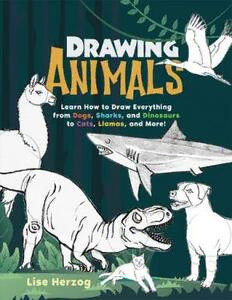
Drawing Animals: Learn How to Draw Everything from Dogs, Sharks, and Dinosaurs to Cats, Llamas, and More! (How to Draw Books) PDF
Preview Drawing Animals: Learn How to Draw Everything from Dogs, Sharks, and Dinosaurs to Cats, Llamas, and More! (How to Draw Books)
GETTING STARTED Drawing Animals is all about positioning shapes into two dimensions so that they are wild, fluid, and moving, with the ability to jump off the page. Don’t freeze your animals on paper with clean contours and highly detailed features. Instead, bring your animals to life with the techniques I will teach you in this book. Your work will stay in motion with the bare minimum of necessary detail—letting the imagination breathe life into the animal. You can group animals together by their common features. In these “families,” many of the animals’ general forms will be similar, but the details will change. Once you know how to draw an animal, it will be easy to draw others from the same group. This book offers basic sketches of animal families, such as marine mammals, rodents, and cats, and it will be up to you to complete the details specific to other animals that are not featured here. Some animals have proportions and shapes that seem too difficult to faithfully reproduce. Noticing details is essential. When re-creating these animals, try variations such as stretching the legs, shortening the muzzle, or lengthening the ears. Adding unique details and presenting an overall impression are what count, much more than replicating the proportions exactly. Before you start, study your animal subject and try to imagine that it’s transparent. Visualize the different layers it is made of and how it compares to other animals. Mapping the various sizes of the animal’s features, limbs, and joints will help you flesh out its full shape. Start by drawing a base made of simple shapes before adding body contours and details. For this step, it is best to use a graphite pencil, which allows you to start your drawing lightly enough that it can be easily erased. When you’re done with your initial sketch, add detail using any drawing tool you prefer. Pencils, as used in the shark drawing below, accommodate light or dark shading, depending on how much pressure you apply to the tip. Pens and markers allow for a consistent intensity of black and are great for curved lines. Ballpoint pens draw both soft, light lines and dark lines. Whichever tools you end up using, remember to take your time— observe, pause, and draw—and accept being imperfect! Each mistake you make will sharpen your gaze and strengthen your drawing skills. MARINE ANIMALS For most marine animals, it’s best to start the body by drawing a curve similar to an inverted comma shape. Each species will have unique features that you can add later; but generally, the head should be placed on the thickest side of the body (the decimal point of the comma). It’s important to keep the body looking flexible and sinuous. After drawing the dolphin’s body, add more features like the dorsal fin, the triangle-shaped tail, and—one of the more unique characteristics for dolphins—the snout. Draw the two small fins near the head like small wings, with one behind the other to make your drawing look more three-dimensional. Then re-sketch the contours and add a few more line details to give your dolphin a wet, sleek look—like it’s swimming in the ocean. Porpoises have compact heads and small, triangular snouts, so make sure to highlight those features. Then add additional detail to make your drawing really stand out. Whales, on the other hand, have stretched-out snouts, and their fins are farther down the sides of the body than a dolphin’s fins. Recognizing and applying these different proportion details is guaranteed to make your drawing look amazing and accurate! Sharks are easy to identify because of their prominent snouts, rows of sharp teeth, and, of course, the pointed dorsal fin. Some fish can have very unusual features, like the hammerhead shark, whose head is perpendicular to the line of its body! FINISH YOUR DRAWING WITH A BLACK PENCIL With a black pencil, you can draw lines that are dark and rich, or soft and powdery if you don’t press too hard. However, be careful because lines made with this pencil don’t blend well. First, redraw the marine animal with the black pencil. Then erase the original gray pencil lines as much as possible. To add “color” to the body, press lightly on the tip of your pencil and shade certain areas. This will create a soft-looking surface.
